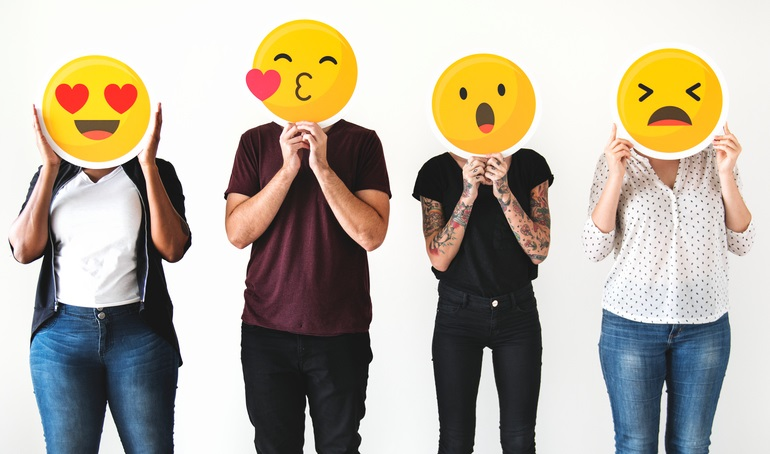Emojis started out as a series of simple emoticons built directly from text (the emoticon was first used in the early 1980s). Since then, they’ve developed into a series of pictures, with more than 2,800 options to choose from as of early 2018.
Now, emojis are moving beyond static imagery. There’s emoji GIFs, customizable Bitmojis avatars, and AR-powered emoji stickers and animations — all which can be used to enhance the mobile messaging experience.
“Customer love for emojis is growing by the year, and brands shouldn’t miss the opportunity to add these playful characters into their next mobile campaign,” Joyce Solano, SVP, global marketing, Leanplum , said.
According to Statista, the popularity of mobile messaging apps continues to grow. Whatsapp, Facebook Messenger, and WeChat have more than 1 billion users on their platforms, respectively, with WeChat, Skype and Snapchat in the hundreds of millions.
Using emojis can change the narrative of your mobile marketing campaigns. Here are three tips to help you get started:
Understand the medium
Think about using emojis the same way you would any other type of personalized content strategy. Messaging needs to be clear, engaging, and relatable for the audience you’re trying to reach.
“While emojis are certainly fun, make sure they don’t feel extraneous or out of place,” Itai Leibowitz, product manager, Facebook Messenger, said.
Emojis are pictographs, which poses some risk for multiple interpretations. If your messaging is unclear, it could lead to some terrible (and hilarious) marketing mix-ups.
“Marketers first and foremost must deeply understand their audiences and the channels they interact with to use a communication tool like emojis well,” Carl Agers, SVP, marketing services, Hero Digital, said.
So, know your emojis, and what they mean, before you use them. If you’re ever stuck, or in doubt, you can always check the Emojipedia for reference.
Emoji with purpose, and tap into intent
For Travis Montaque, CEO, Emogi, it’s important for brands to consider their own positioning and purpose, too. For consumers, he says, “brands are a part of the way you express yourself,” because those are the products that are integrated into your everyday experiences.
“Go beyond your branding,” Montaque said. .”What are you going to offer someone in that moment?”
Emogi uses NLP-based machine learning to help surface relevant content within messaging conversations, based on user preference and intent in real-time. The ability to understand audiences contextually can help create better, and more useful, tools for conversation. In short — if you create emojis people want to use, and fits into the narrative of their lives, they’ll use it.
Montaque gave an example of one simple way context can change an entire emoji experience: how different people travel to work, depending on where they live.
“In the suburbs, you may be getting into a car, but in the city, it could be that you’re swiping a MetroCard or getting on a subway,” Montaque said. It’s the same action (going to work) but with emoji, it’s expressed in very different ways.
Marissa Aydlett, CMO, Braze, says in order to stand out, brands should use data and technology as “the engine for creativity,” to build conversational experiences on mobile.
“Think of it like brand EQ; where brands listen, pick up on cues, and, when relevant, respond with value,” Aydlett said.
Get in on real-time conversations
The benefit of mobile messaging is the ability to engage users in real-time. Brands can approach this in several ways — from custom branded emojis, gamified CTAs, and imagery centered around timely events.
In Messenger, emojis, coupled with AR, can transform in-app shopping experiences.
“Nike [for example] dropped a limited edition pair of Kyries through their SNKRS experience in Messenger. To ‘unlock” a pair of Kyries, people had to enter an emoji code, which would then open the camera,” Leibowitz said. “Using AR, the shoe was placed on a pedestal in their physical environment,.”
Emojis in push notifications or email can help add a bit of spark to real-time campaigns.
“If you’re a retailer and having a 4th of July sale, send a sponsored message and use a fun, branded emoji to let your customers know in real-time that they have 24 hours to get 25 percent off all store merchandise,” Leibowitz sad.
“Or, maybe you need to remind a customer about an upcoming appointment; use an alarm clock emoji to let them know that it’s fast approaching.”
“We’ve seen brilliant uses by brands in mobile push notifications, a message that users scan, usually in the midst of doing something else, and expect to be short and to the point – a perfect place for an emoji,” Agers said.








